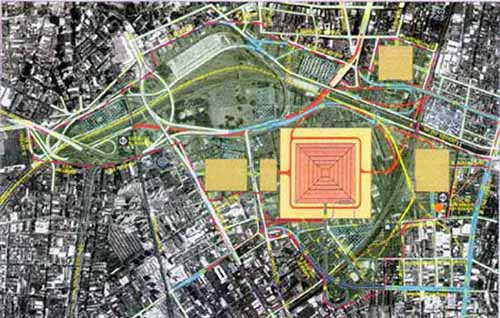sp tower |
|
|
SP Tower

In 1999 occurred in Sâo Paulo an intense debate around urban interventions, focused in a vast project of reurbanization, based on the construction of a mega architectural complex, to be installed in Pari. Perhaps the only sector of city propitious _ because of its extension, road infrastructure, proximity to the center and availability at low costs due to a long period of disinvestment _ to absorb something of this dimension. This megaproject implies a great alteration in the scale of the interventions and in the limits foreseen by the zoning and the lines established for operations.
Beyond the evident not interest in the maintenance of old buildings, it considers the construction of a new model of financial center. The proposal, made by an international investment fund in partnership with a local group, seems to indicate a new scale of the land / financial operations that dictate the space organization of the city. It is a radical transformation of the urban morphology, legitimated through the rules of use and occupation proposals flexibilization, but with a differential: the international capital, subordinating the public regulations and investments, determine the pattern of the urban territory.
The megaproject indicates a trend that will base the future investments in the urban restructuring of São Paulo, large projects of real estate and urban development promoted by the international capital, indicating the potential insertion of São Paulo in the system of the global cities. Projects that tend to concentrate in great architectural complexes all the programs of the urban fabric, to create areas of production concentration, services and habitation directly linked to similar patterns in other worldwide metropolises, relatively independent of the remainder of the city. They also tend to install corporate cultural equipment integrated to the international circuit of arts and spectacles, definitively suppressing the traditional public spaces.
It is a large-scale process, which only can be understood in the scope of the global integration dynamic. The spatial restructuring doesn’t happen anymore in an intra-urban scope. A configuration of territories that do not correspond anymore to the old design and the administrative zoning of the city. An urban geometry, with complex and intensive spacializations, that cannot be apprehended by experience. The SP Tower indicates a new stage of the city urban restructuring: the impact of the constitution of global scale territory in the space of the metropolis.
The new scales introduced by these enterprises radically conflict with the previous directions of planning and zoning, also escaping of the more recent disposals than aimed at to reorient investments for central areas. These new large projects demand a complete change of the legislation that regulated the occupation of the urban space, besides entirely subordinating the public investments to its necessities. They disclose the urban policies limitations on promoting requalification, in dealing with the new economic dynamic and space resultants of the global integration of the country. They demand new urban, architectural and aesthetic strategies, opposed to the corporate appropriation, the social exclusion and the homogenization of urban spaces and art.